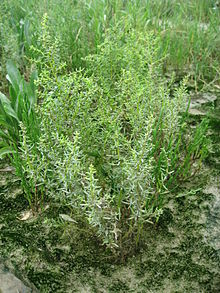Suaeda maritima
| Suaeda maritima | |
|---|---|

| |
| Scientific classification | |
| Kingdom: | Plantae |
| Clade: | Tracheophytes |
| Clade: | Angiosperms |
| Clade: | Eudicots |
| Order: | Caryophyllales |
| Family: | Amaranthaceae |
| Genus: | Suaeda |
| Species: | S. maritima
|
| Binomial name | |
| Suaeda maritima | |
| Synonyms[1] | |
|
show
List | |
Suaeda maritima is a species of flowering plant in the family Amaranthaceae known by the common names herbaceous seepweed[2] and annual seablite.
Description[]
It is a yellow-green shrub with fleshy, succulent leaves and green flowers. It grows to about 35 cm in salt marshes.[3] It is edible as a leaf vegetable, and due to its high salt content it can be used in combination with other foods as a seasoning. It is found worldwide, but in North America it is primarily located on the northern east coast.
Habitat[]
This plant resides in aquatic, terrestrial, and wetland habitats. [4]But mainly in salt marshes and sea shores, usually below the high water mark. Additionally, Suaeda maritima is able to catch mud and help build up the marshes.[5]
Development[]
The leaves are simple and arranged alternatively, with one leaf per node along the stem. Their leaves also absorb large amounts of salt and will turn red when oversaturated.[5] [6]The flower can be either radially symmetrical or bilaterally symmetrical.
Life Cycle[]
The life cycle of Suaeda maritima is known to be mainly annually. This plant will perform its entire life cycle from seed to flower then back to a seed within a single growing season. All roots, stems and leaves of the Suaeda maritima plant will die and the only thing that can bridge the gap between each generation is a dormant seed.
Medicine[]
There are currently no known medical sources that the Suaeda maritima plant is used for.
Food[]
The young leaves of sea blite can be consumed raw or cooked. [7]Although it has a strong salty flavor. The seeds can also be consumed raw or cooked. The ashes of the sea blite have been used to create a material used in making soap and glass.
References[]
- ^ "Suaeda maritima (L.) Dumort". Plants of the World Online. Board of Trustees of the Royal Botanic Gardens, Kew. 2017. Retrieved 12 July 2020.
- ^ "Suaeda maritima". Natural Resources Conservation Service PLANTS Database. USDA. Retrieved 4 December 2015.
- ^ "Annual seablite Suaeda maritima". wildflowerfinder.org.uk. Retrieved 5 September 2012.
- ^ "Plants Profile for Suaeda maritima (herbaceous seepweed)". plants.usda.gov. Retrieved 2020-12-17.
- ^ Jump up to: a b "Suaeda maritima : Annual Sea-blite | NBN Atlas". species.nbnatlas.org. Retrieved 2020-12-17.
- ^ "Suaeda maritima (herbaceous sea-blite): Go Botany". gobotany.nativeplanttrust.org. Retrieved 2020-12-17.
- ^ "Suaeda maritima (Sea Blite) - Practical Plants". practicalplants.org. Retrieved 2020-12-17.
- Suaeda
- Halophytes
- Barilla plants
- Flora of Canada
- Flora of the Northeastern United States
- Flora of the Southeastern United States
- Amaranthaceae stubs
